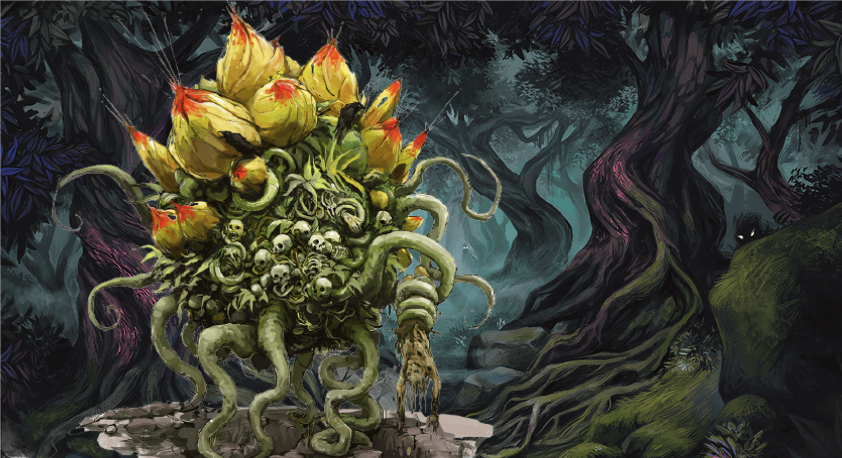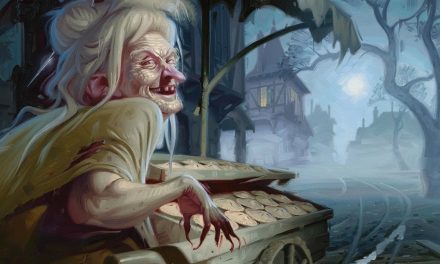With the stench of death and a malevolent hatred of the living, the Corpse Flower crawls towards its next meal.
These large plants take only weeks to grow to their full size from a seedling. They may be found growing around the remains of powerful undead, necromancers, or other such ghoulish entities.
With a never-ending hunger and some truly devastating effects, this is the Corpse Flower in D&D 5e.
What Is A Corpse Flower in D&D 5e?
Originating from seedlings that sprout in corrupted soils of undeath, the Corpse Flower uproots itself when it reaches its full size. From there, it begins its slow crawl across the lands in search of humanoid corpses to consume.
The Corpse Flower particularly favors sites with large amounts of corpses to feed on. In graveyards and battlefields, it uses its long tentacles to collect bodies and stuff them into its form. These corpses not only nourish the Corpse Flower – they can be used to repair it of any damage that it may have suffered.
Though we can’t mention the Corpse Flower without also discussing its odor.
Whether or not the Corpse Flower has bodies in it, it releases a constant stench. This smell is potent enough to overwhelm and incapacitate nearby creatures as they retch and gag. Even after a Corpse Flower has been killed, this odor lingers for several days.
Running a Corpse Flower in D&D 5e
The Corpse Flower is an interesting monster, to say the least. Let’s take a closer look at the core mechanics of the Corpse Flower in D&D 5e.
Corpses! Friend or Food?
With the grotesque ability to use corpses trapped within it as either food or allies, the Corpse Flower can be a very tough encounter.
When the Corpse Flower is encountered, it already contains 1d6+3 corpses. These will either be used for 2d10 healing or will be turned into zombies. Though the zombies aren’t under the Corpse Flower’s control, they are allies of it and also carry the Flower’s Stench of Death ability.
As a bonus action, the Corpse Flower can either spawn a zombie to help defend it or consume a corpse to heal itself.
The Stench of Death
Based on the description of the Corpse Flower, a 10ft range from the Corpse Flower (or its zombies) is admittedly a bit smaller than I expected.
But this ability isn’t to be taken lightly! It takes a DC 14 Constitution saving throw for a character to avoid being incapacitated until their next turn.
On the bright side, a character who succeeds on their Constitution saving throw is immune to the stench for 24 hours. This would also extend to the zombies that the Corpse Flower spawns.
The Corpse Flower’s Tentacles
Oh boy does this thing hit hard!
With its multiattack, the Corpse Flower makes three attacks. What this ghoulish plant lacks in speed, it makes up for with a reach of 10 feet.
Not only does the target take bludgeoning damage as the Corpse Flower smacks them with its fibrous tentacle, but they also have to make a DC 14 Constitution saving throw. If they fail this saving throw, they take an additional 4d6 poison damage in addition to the 2d6+2 damage from the tentacle itself.
Because the Corpse Flower has the Spider Climb ability, it would certainly be clever enough to climb to a position where the party can’t reach it. From this perch, it can thrash out at the party in relative safety.
Beyond this base level of instinct, though, the Corpse Flower is not a particularly intelligent creature. Because it navigates with blindsight (and can’t “see” beyond 120 ft), it will largely swipe at whatever enemy happens to be closest or more convenient.
However, the Corpse Flower would have no reason not to continue attacking a character who has dropped to 0 hit points. As they are on death’s door, the Corpse Flower continues thrashing at them until it can use its next ability…
And it’s a fun one…
Harvest the Dead
As an action, the Corpse Flower can grab an unsecured humanoid corpse from within 10 feet of itself. It stuffs the corpse into itself to be used later. Naturally, this also includes any equipment that the corpse was wearing or carrying.
Of course, the real horror is if one of the party members are killed in the fight. It’s difficult to say which is more terrifying: being digested for healing or being reanimated as a zombie ally of the Corpse Flower.
The use of the word unsecured in this ability’s description is a little strange, but makes sense. If a corpse is chained to a wall or some other such thing, the Corpse Flower can’t harvest it.
Which Corpse to Choose?
If a character is killed and then ingested by the Corpse Flower, a spectacular tension begins to form at the table.
If the Corpse Flower uses a corpse for healing itself, nothing of the body is left as their equipment is spit out. Similarly, coming back as a zombie prevents most forms of resurrection. In either case, it would take a Wish or True Resurrection to bring the character back.
So as the fight goes on and the Corpse Flower continues to use its corpses to fuel its abilities, how do you decide which corpse the Corpse Flower uses?
It feels like a jerk move to arbitrarily decide that the PC’s corpse is the first one that the Corpse Flower uses. Of course, assuming that there are more than one corpses in the Flower.
But, on the other hand, saving the PC for last removes (or at least delays) a major threat created by the encounter.
The Corpse Flower is a plant. It doesn’t care. It just feeds.
So I say leave it up to a dice roll.
If there are 5 corpses (including 1 PC) in the Corpse Flower, roll a d6. If you roll a one, the PC’s corpse is the one that is used. Reroll on a 6.
Leaving it up to fate as a type of Russian roulette creates wonderful tension at the table as the odds of the character being chosen increase with every round. The rest of the party has to hurry and drop this thing if they want to have any hope of restoring their friend to life.
Of course, as the DM you can always add a little spice and offer to let the player roll to determine which body is chosen by the Corpse Flower…
Conclusion – The Corpse Flower in D&D 5e
The Corpse Flower just oozes creepiness and is almost guaranteed to be a memorable encounter for your party. Of course, whether that is a good or bad thing remains to be seen…
The zombies that it creates are weak, but do work to spread the Stench of Death and eat some damage that would otherwise be directed at the Corpse Flower. While the party tangles with zombies and retches from the smell, it is able to slowly work its way within range to attack.
Of all of the entries in Mordenkainen’s Tome of Foes, this is the one that has consistently stuck with me the most. Depending on whether or not the party underestimates the Corpse Flower (and if they can make their Constitution saves), this can quickly lead to a particularly-grim TPK.
Have you used or encountered a Corpse Flower in your game?
How did it go?
Let’s talk in the comments!
You can get the Corpse Flower along with tons of other incredible enemies and lore in Mordenkainen’s Tome of Foes!









